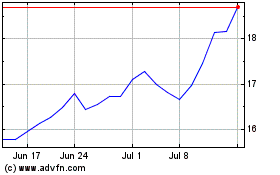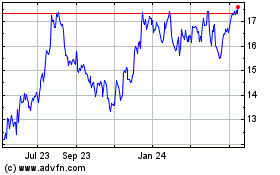By Rachel Louise Ensign
Business borrowing is picking up, a welcome relief for banks and
a sign of strength for the U.S. economy.
Preliminary second-quarter data from the Federal Reserve
indicate the year-over-year growth rate of business loans rose to
5.5% in late June from less than 1% near the end of 2017. The
upturn marks the reversal of a prolonged slump in business-loan
growth that began in earnest about two years ago.
The rebound reflects increased confidence at companies. In
April, Manvee, a Milwaukee-based wholesale bakery, decided to take
out loans for more than $4 million from Indiana-based lender Old
National Bancorp, said co-owner Thomas Roepsch.
"We're trying to keep up with growth," he said. "People are
knocking on the door asking for more of our products."
Manvee, which bakes doughnuts, muffins and other goods that are
then sold at retail stores, plans to use the loan to expand into
Indiana and invest in automation and delivery trucks, Mr. Roepsch
said.
The potential spoiler is trade tensions, which could make
businesses more cautious. The Federal Reserve's rate-setting
committee, at its June meeting, expressed concern about the effect
tariffs and trade restrictions could have on future investment
activity, according to minutes released last week. Contacts in some
Federal Reserve districts "indicated that plans for capital
spending had been scaled back or postponed as a result of
uncertainty over trade policy," they said.
For banks, the acceleration in lending may help lift results
when firms report quarterly results this month. Profits from
lending are a major component of bank earnings and grow when total
loans increase or rates on loans rise. Business-loan growth often
helps on both fronts because these credits typically carry floating
rates that allow banks to capture rate increases.
"We've been waiting for this ever since the 2016 election,"
Scott Siefers, a bank analyst at Sandler O'Neill + Partners
said.
A slowdown in businesses' appetite for bank loans began to
gather pace in summer 2016, a few months before the 2016
presidential election. Lending growth, which had exceeded 10% for
much of the prior two years, dipped into single digits.
Most bankers expected that optimism among business owners in the
wake of Republican President Donald Trump's surprise victory would
lead to increased borrowing. Instead, loan growth continued to
fall, reaching a rate of around 0.5% in December 2017.
The fall-off dampened bank profits. Just as troubling for
bankers: Broader economic data was solid and there weren't obvious
reasons for the decline.
Some bankers attributed it to competition from nonbank lenders
or a lack of confidence at companies due to political upheaval.
The exact reason demand for business loans has risen of late is
tough to pinpoint. Many analysts point to metrics that show
businesses have a rosier economic outlook. Some bankers think
midsize clients are laying plans to expand, including through
acquisitions, and are drawing on lines of credit to fund those
endeavors, according to a federal advisory council of bank
executives.
"Businesses no longer have an excuse not to borrow. Whether it
was the election, deregulation or taxes -- now we have the answer
to all three," said Chris Marinac, director of research at FIG
Partners LLC. "They have every reason in the world to take on debt
and expand."
Business loans are growing faster at small and midsize banks
than they are at the biggest U.S. lenders, according to Fed data.
These smaller lenders tend to focus on businesses outside of the
largest corporate firms.
At Green Bay, Wis.-based Associated Banc-Corp, clients started
to seem more interested in borrowing last year as the tax overhaul
took shape, said David Prince, executive vice president for
commercial banking. Now, they are taking out loans, driven by both
a bullish economic view and a desire to borrow before rates rise
much further, he said.
Stronger business-loan growth is helping lift broader lending
growth. Overall loan growth at banks increased to a 5%
year-over-year growth rate in late June from 3.9% at the start of
2018, according to Fed data. Growth in some other categories of
lending, such as for commercial real-estate projects like apartment
buildings, by contrast, is slowing.
Accelerating loan growth could pressure some banks to raise
deposits to fund loans, although most banks still have
loan-to-deposit ratios that are low enough to provide them with
lending headroom.
That is fortunate because while deposits are still growing
across the industry, they are doing so at a slower pace than in
recent years. And the three largest national lenders, JPMorgan
Chase & Co., Bank of America Corp. and Wells Fargo & Co.,
continue to garner much of the growth in deposits.
That is causing some smaller banks to pay higher interest rates
to attract more deposits. The downside is this can eat into the
profit margin on loans, cutting some of the benefit of increased
volume growth.
There also are concerns that banks, eager for growth, are making
business loans with looser terms that may lead to problems in the
future.
In a May report, the Office of the Comptroller of the Currency,
or OCC, identified the easing of commercial-loan standards as a top
risk in the banking industry. While the rate of bad business loans
remains low, and most banks still have a moderate risk appetite,
the regulator said that during the past year it privately issued
more warnings ordering financial institutions to modify their
business-lending practices.
The OCC said banks are extending interest-only periods on
commercial loans, allowing borrowers to draw down bigger portions
of the value of collateral and relaxing covenants meant to protect
from losses.
One big concern: While rising rates will make the loans more
lucrative for banks, they may make it harder for businesses to pay
off the loans, the OCC said.
(END) Dow Jones Newswires
July 08, 2018 10:14 ET (14:14 GMT)
Copyright (c) 2018 Dow Jones & Company, Inc.
Old National Bancorp (NASDAQ:ONB)
Historical Stock Chart
From Mar 2024 to Apr 2024

Old National Bancorp (NASDAQ:ONB)
Historical Stock Chart
From Apr 2023 to Apr 2024
